Silk Powder
In 1936, Kinu Ltd. was established at 6 Finsbury Square, London with a capital of £100. The following year the company released its Kinoo line of cosmetics – including a face powder, dusting powder, baby powder, tonic skin food lotion, foundation cream, cleansing cream and night cream – all containing powdered silk.
Edward Erlick Verdiers, the chief chemist of Kinu, suggested that powdered silk’s absorption and adsorption qualities helped face powders retain a matt finish even under trying conditions and also soaked up moisture in baby and dusting powders. Powdered silk was used in other Kinoo cosmetics but Verdiers’ reasons for doing this were absent or less convincing.
“Kinoo” face powder, of which 90 per cent. is claimed to be pure silk, the remaining 10 per cent. being composed of perfume and colouring matter, may be obtained either in a “transparent” or “opaque” form, the difference lying in the way it is treated. There are eight shades, including green and pale violet … obtainable in attractive black and silver boxes.
Of the remainder of the series, which are all claimed to contain a certain percentage of pure silk, the tonic skin food lotion is, perhaps, the most interesting, as, besides being a skin tonic, it is claimed to act as a filter for the ultra-violet rays of the sun and promotes tanning without burn. Foundation cream, cleansing cream and night cream are all labelled “activated.” The dusting powder and baby powder both contain 90 per cent. pure silk.(‘Silk as a cosmetic ingredient,’ 1937, p. 111)
Powdered silk
Powdered silk was not a new commodity. It had been used for centuries as a medicinal and had also been incorporated into a number of commercial products, most notably wallpaper and artificial flowers. Flock wallpaper, for example, had been made in Rouen, France using powdered silk as far back as 1620 (Ackerman, 1923, p. 10).
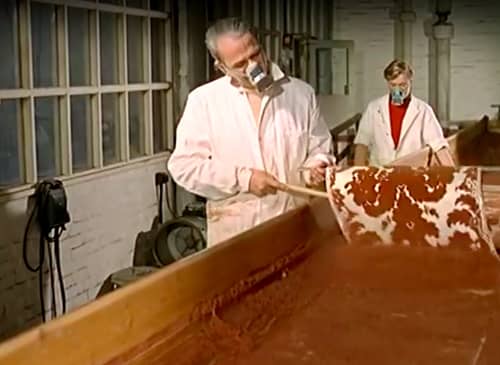
Above: 1963 Flock wallpaper being made. The paper is printed with glue rather than colour and covered in powdered silk or wool while the glue is still wet, the excess then shaken off (British Pathé).
Early silk powders were made by laboriously cutting and pulverising waste silk but the process was made easier by treating the silk with chemicals to make it brittle before it was pulverised.
Silk powder as a means of ornamentation of paper is the idea of a French patentee. The powder is applied to the paper in the usual manner. The process of manufacture is simple, consisting mainly of a thorough cleansing of the silk waste and steeping in a warm solution of tin crystals and sugar to obtain the required brittleness, after which there is the process of drying, grinding, weighting with silicate of soda, dyeing, softening with a solution of Carragheen moss, and a final drying. The last process is done in a rotating mill furnished with sieves.
(American stationer, 1896, p. 698)
Kinu also used chemicals – an alkali – to make the silk brittle before grinding it into an impalpable powder. Alkalis had been used in the past to dissolve waste silk so that it could be used in the manufacture of soap but Kinu neutralised the alkali before the silk decomposed so the silk fibres were degraded but not dissolved.
The Kinu process was covered by patents – British Patent No: 482,269 (1938) granted to Reginald Wyatt Lawson and British Patent No: 514,070 (1939) granted to Reginald Wyatt Lawson and Edward Erlick Verdiers. Other British patents for the production of powdered silk were taken out by Frederick Hubert Clayton (British Patent No. 519,544, 1940) and Sydney George Phelps (British Patent No. 555, 044, 1942). These also combined chemical treatments with mechanical pulverisation to produce a fine silk powder that could be used in cosmetics.
Unfortunately for Kinu and the other patent holders the production of powdered silk was effectively ended by the outbreak of the Second World War. After 1939, any available stocks of silk were requisitioned for the war effort to make military items like parachutes and powder bags for explosives, effectively bringing non-military uses of silk to an end for the duration of the war.
See also: Cosmetic Stockings
Helena Rubinstein
When supplies of silk became available again after 1945 it appears that the work started by Kinu into using powdered silk in cosmetics was taken up by Helena Rubinstein. Woodhead suggests that Rubinstein bought the Verdier patents after Verdier had been left in the lurch by Sita Devi [1917-1989], the Maharani of Baroda. According to Woodhead, Sita Devi had promised to invest in Kinu but had failed to deliver the funds (Woodhead, 2003, p. 330). Verdier had then come to an arrangement with Boris Forter (né Kougoulsky) [1896-1976], the managing director of the British arm of Helena Rubinstein, and Helena Rubinstein then began manufacturing powdered silk in a special facility set up in the Rubinstein factory in Surrey.
The first Rubinstein cosmetics containing powdered (‘atomised’) silk – Silk-Tone and Silk-Film – were introduced in 1948. Silk-Tone was a liquid foundation and Silk-Film a compressed cream powder. The fact that Rubinstein did not start with a silk face powder suggests that the company was using silk powder primarily as a marketing ploy.
Poets throughout the ages have sung of skin like silk . . . and Helena Rubinstein has gone to the source of silk itself to give your skin the look of silk . . . the feel of silk . . . the long-lasting beauty of silk.
(Rubinstein advertisement, 1948)
Despite the fact that the initial interest came from Britain and the powdered silk appears to have been manufactured there, Silk-Tone and Silk-Film were first released in the United States. Britain would not get Rubinstein cosmetics containing powdered silk until 1950, by which time Rubinstein was also making Silk Screen Face Powder and Silken Lipstick.

Above: 1950 Helena Rubinstein cosmetic pack as released in Britain consisting of Silk-Tone Foundation, Silken Lipstick and Silk Screen Face Powder.
“Atomised” Silk face powder, just introduced by Helena Rubinstein, Ltd. … is in fact produced from natural silk at the company’s factory at Hook Rise, Tolworth, Surrey. The frothy silk is autoclaved to remove any substance likely to cause allergic reactions, washed and dried in an electric drier (in which it remains for twelve hours). The dry silk is next put into a micro-pulveriser, and “atomised”. In another section of the factory the rest of the ingredients are mechanically mixed and coloured. The silk powder has three millings before being mixed with the other ingredients. The final preparation then goes back into the micro-pulveriser, where the “atomising” process is repeated for the last time. The finished product is automatically weighed and packed. “Atomised” Silk face powder is considerably lighter than any other powder, and most economical in use.
(‘Trade Notes,’ 1950)
Continental developments
Interest in using powdered silk in cosmetics also developed on the continent after the war. In France, silk powder (poudre de soie) was championed by the chemist Jean Morelle. In June, 1947, he published a paper on the cosmetic uses of powdered silk in ‘La Parfumerie Moderne’ which outlined its absorbent, antiseptic and colouring possibilities. In 1950, Morelle followed this with a paper on cosmetic colourants which included a diagram highlighting silk powder’s potential as a colourant for lipsticks (rouge à lèvres), powders (poudres) and nail polishes (vernis à ongles).

Above: 1950 Les matières colorantes sur soie en cosmétologie. Trans: Silk dyestuffs in cosmetology (Morelle, 1950, p. 53). The silk powder could be coloured with a dye and then dispersed in make-up as a lake colour.
Morelle’s work suggested a solution to a common problem that existed in indelible lipsticks at the time, namely that the stains left on the lips from bromo acids were often distinctly different from shade of the lipstick on the lips when first applied.
See also: Indelible Lipsticks
Rather than manufacturing an indelible lipstick with a mixture of dyes and pigments the lipstick could be coloured with powdered silk dyed with bromo acid. The dye in the silk would still stain the lips but now the colour of the lipstick would be the same as the residual stain left on the lips.
If the silk colours live up to the enthusiastic claims made for them, it is possible that they may bring about a revolution in the formulation and manufacture of lipsticks.
The silk “lakes” are produced by dyeing the powdered silk manufactured for use in cosmetics. The powder, which has an extremely small particle size, will absorb from 20% to 30% of its weight of a saturated solution of tetrabromo fluorescein (bromo acid) and the silk protein has a strong affinity for the dye. The silk powder mat be dyed the exact shade desired in the lipstick by using the right combination of dyestuffs, and the work of blending the lakes and toners is thus eliminated from the manufacturing process. The shade of ordinary colour lakes is sometimes altered during milling, since the article size influences the colour effect, but the use of silk lakes eliminates this variable as milling is not required.
The powdered silk colours produce a stain on the lips in addition to colouring the superficial greasy film of lipstick. consequently it is not necessary to incorporate free bromo acid in the lipstick in order to make it indelible.
Castor oil may be omitted from the formula since a bromo acid solvent is not needed and as a result the lipstick is less susceptible to rancidity.(Powdered silk for cosmetics, 1950, p. 216)
It would appear that Rubinstein’s Silken Lipstick used this idea as did some cosmetics developed on the continent. However, many cosmetic chemists remained unconvinced. The influential American cosmetic chemist, Maison de Navarre examined French and British-made pure silk powder after the war but could find little to recommend it.
When used in face powder in concentrations up to 55%, no useful advantage seemed to be gained according to users of the powder. The silk powder replaced high-grade talc. Users usually preferred the silk free face powder.
(deNavarre, 1962, p. 265)
As a cosmetic ingredient, powdered silk has not lived up to the promise suggested by Morelle and others. Patents were a limiting factor early on, as was its cost and potential as an allergen. The introduction of translucent powders in the 1960s failed to generate much additional interest but there was some uptake from the 1990s onwards when ‘natural’ cosmetics became more popular.
Silk still retains its ancient allure today and it is still easy to find cosmetics that say they have the look and/or feel of silk or satin. However, those that evoke it often do not have silk in their formulation or, if they do, are made with hydrolysed silk – silk broken down into its proteins or amino acids by alkalis, acids or enzymes – or only a small percentage of silk powder.
6th February 2018
Sources
Ackerman, P. (1923). Wallpaper: Its history, design and use. London: William Heinemann Ltd.
American Stationer. (1896). XL(17), October 22.
deNavarre, M. G. (1962). The chemistry and manufacture of cosmetics (2nd ed., Vol. II). Princeton, NJ: D. Van Nostrand Company, Inc.
Hart Dyke, Z. (1949). So spins the silkworm London: Rockliff.
Morelle, J. (1947). La poudre de soie. La Parfumerie Moderne. June, 29-39.
Morelle, J. (1950). Généralités sur les matières colorantes utilisées en cosmétologie. La Parfumerie Moderne. July/August, 47-55.
Rubinstein, H. (1965). My life for beauty. Sydney: The Bodley Head Ltd.
Silk as a cosmetic ingredient. (1937). Manufacturing Perfumer. July, 111.
Trade notes. (1950). The Chemist and Druggist. October 14, 442.
Woodhead, L. (2003). War paint. Miss Elizabeth Arden and madame Helena Rubinstein their lives, their times, their rivalry. London: Virago Press.
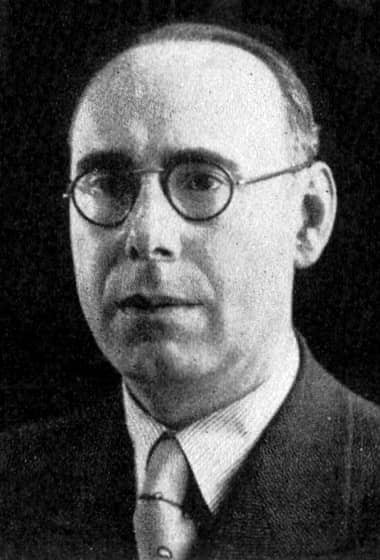
Edward Erlick Verdiers [c.1893-1965].
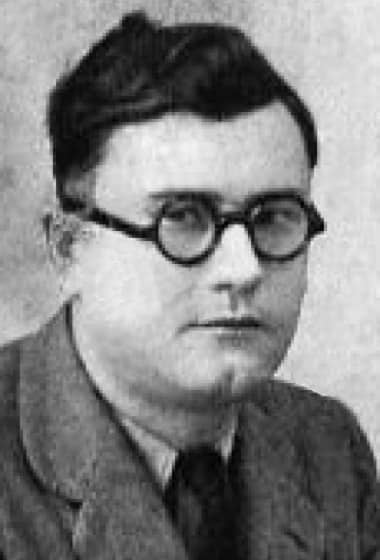
Jean Morelle [1913-2003].

Silkworms (Bombyx mori) and cocoons.
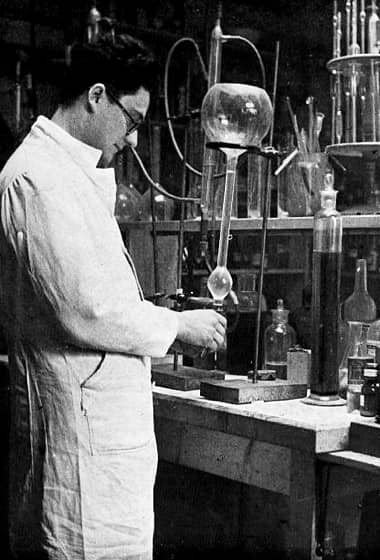
1939 Jean Morelle working in his laboratory.
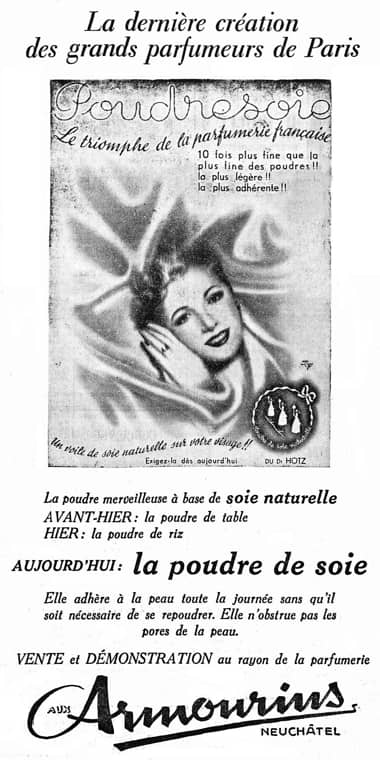
1947 Armourins Poudresoir.
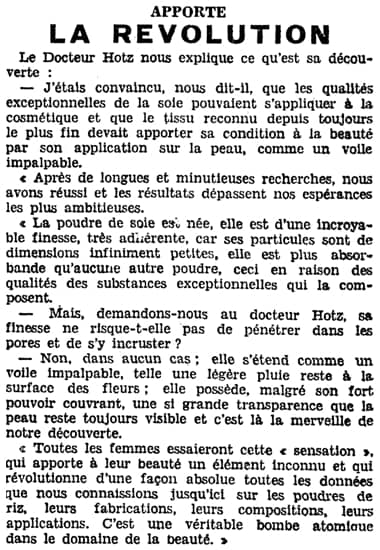
1948 Article by Docteur Hotz on powdered silk.
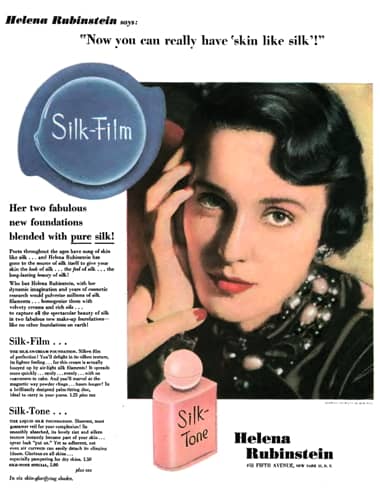
1948 Helena Rubinstein Silk-Tone liquid foundation and Silk-Film compressed cream powder.

1948 Tojan Pudresoir, Crèmesoir and Rougesoir.

1949 Dr. Hotz Poudresoir, Crèmesoir and Rougesoir.
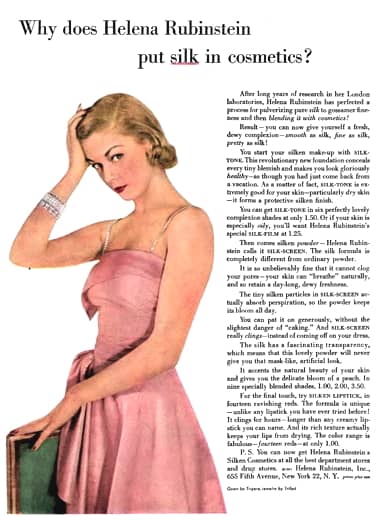
1951 Helena Rubinstein silk cosmetics.
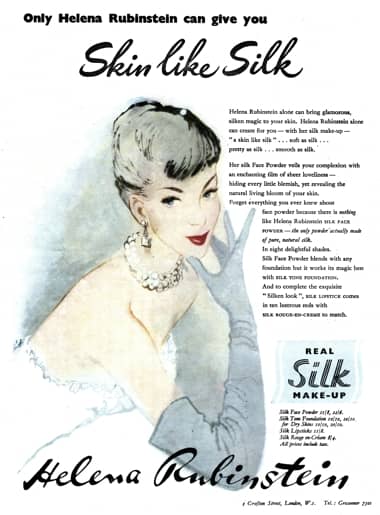
1952 Helena Rubinstein silk cosmetics.
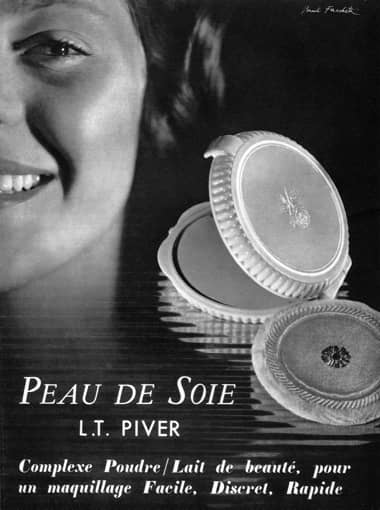
1957 L. T. Piver. Peau de Soie (silky skin) achieved without powdered silk.
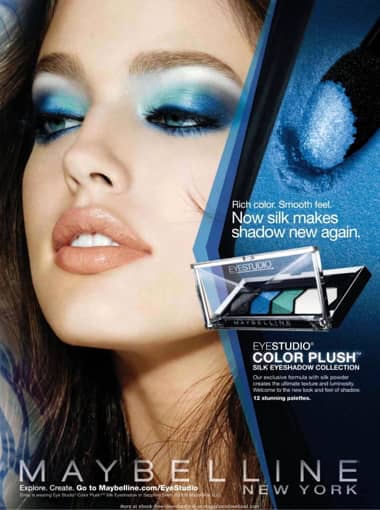
2010 Maybelline EyeStudio Color Plush eyeshadow made with powdered silk.
